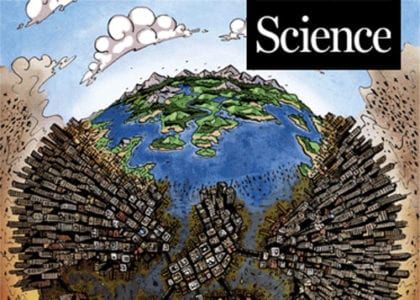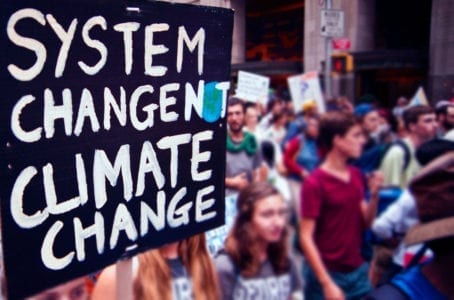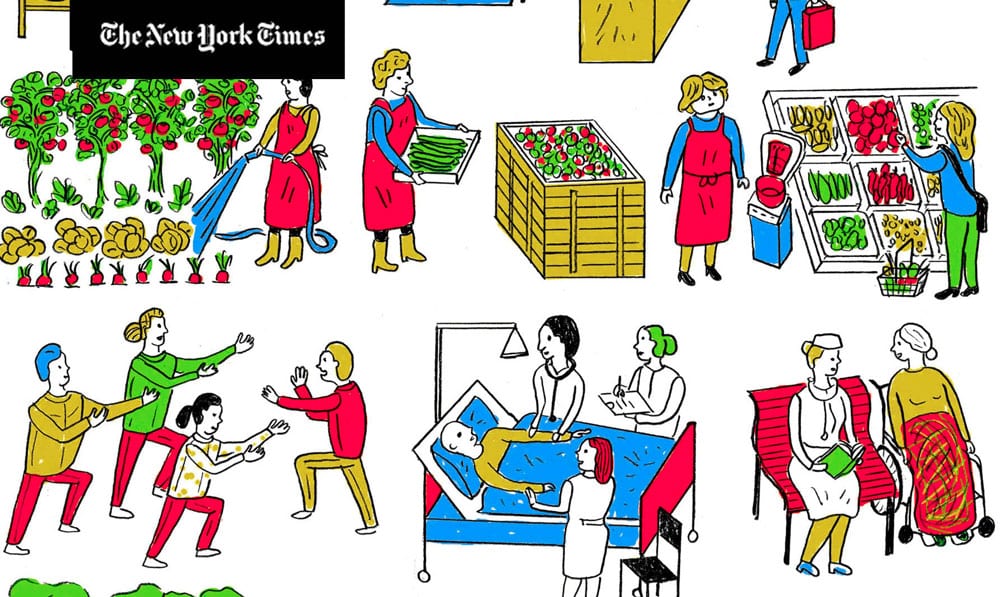Tackling the political economy of transformative change
For Joseph Schumpeter, ‘creative destruction’ was an inherent feature of capitalist development; new key technologies emerge and destroy the old socio-technical paradigm and its industrial structure, leading to a new business cycle of economic growth. What if we apply its logic to transformative political change instead? We have plenty of solutions at hand, Daniel Hausknost argues; it’s time for decisions. This blog is based on an Opening Reflection at the UN Sustainable Development Transformation Forum, 24 October 2019.

When I read the newly released Global Sustainable Development Report (GSDR), it occurred to me that there are two different stories going on in the Report:
One is the story that sounds the alarm—the diagnosis, if you will, that the International Community has miserably failed so far to reach the most critical goals of ecological sustainability. Even worse, some of the most important environmental indicators like greenhouse gas emissions, absolute material footprint and biodiversity loss are moving in the wrong direction with no signs of making the required U-turn anytime soon! This is a devastating diagnosis. The report says that ‘under current trends, the world’s social and natural biophysical systems cannot support the aspirations for universal human well-being embedded in the Sustainable Development Goals’. And it says that ‘the great majority of indicators of ecosystems and biodiversity are showing rapid decline’.
Now, if this story is true—and I am fully convinced it is true—then we are in deep, deep trouble. Because it would mean that unlike in the realm of social and economic development, where some progress has been made, we have achieved nothing and seem to have not the faintest idea of how to achieve our goals.
There is, however, still the other storyline running through the report. And that is the story of hope and feasibility. Here we hear about the ‘shaping of innovative pathways towards achieving the SDGs’, about the need to scale up and adopt sustainable technologies, the need for more science and more knowledge, the need to encourage sustainable investment, the need for more and better governance on all levels and the need for ‘a global decoupling of GDP growth from the overuse of environmental resources’. All of these are no doubt important levels and levers of action and I know that UN documents need to adopt a language that is cautious, diplomatic and does not alienate any of the stakeholders. But moving from diplomacy to the real world, I cannot help but notice that these are the very same strategies and action plans that have been around for the past 20 to 30 years and that have failed us.
This is not about criticising the GSDR, but I do sense a quite dramatic mismatch of the two storylines running through the report; a quite dramatic mismatch between the diagnosis of a life-threatening disease and the proposed treatment for flu-like symptoms.
In his book ‘The Conflict of the Faculties’, philosopher Immanuel Kant tells the story of a doctor who consoles his seriously ill patients with hopes of a speedy convalescence by telling them that their pulse beats better or that their stool has improved or that their perspiration has improved, and so on. One day he asks one of his patients how he is doing and the patient replies: ‘How should I be? I’m dying of improvement, pure and simple!’
Tough as this may sound, the ‘sustainable development’ we have seen in past decades is just that: a dying of improvement. And if we stick to the same medication that has not attacked the root causes of our illness in the past, then we will indeed be dying of symptomatic improvement, quite literally.
Of course, I don’t have the prescription for the right medicine in my pocket! However, I do think that if we seriously want to talk about transformative change, then we first need to let go of a few stubborn myths that block our minds.
Myth number one is the widespread belief in the feasibility of an absolute long-term decoupling of global environmental pressures from economic activity in a growth-oriented economy. It’s the myth of green growth. Decoupling an economy that is addicted to growth from its material and energetic base is impossible. I am part of a larger team of researchers that is currently undertaking a systematic review of the empirical evidence of absolute decoupling around the world. We assessed more than 800 publications from the past 20 years and found no evidence of the possibility of long-term and substantial absolute decoupling within the existing economic model. Those instances of decoupling that can be observed (like the UK or Germany in past years) result mainly from deindustrialisation and the outsourcing of energy-intensive industrial production to other countries. However, if we take the consumption of goods and services into account, we come to realise that absolute decoupling is not happening—at least not at a significant and meaningful level. Decouple we must, however, but this will arguably require a politics of sufficiency to complement efficiency, meaning that the absolute levels of consumption at least in the rich countries must decrease quite considerably. The outlook on a politics of sufficiency and on a degrowing consumption level, however, is arguably incompatible with market Capitalism (and here I deliberately use the ‘C’ word that has been the elephant in the room and that no one has mentioned in three days).
Myth number two is the believe in—and the reliance on—conscious individual behaviour change. There is mounting scientific evidence that our continuous efforts to convince consumers in rich countries to finally become ‘sustainable’ is, by and large, futile. Insights from environmental sociology show that individual behaviour is embedded in and guided by social, cultural and material structures that constitute the riverbed in which our behaviour flows. Add to that the insight from behavioural science that our brains have to navigate more than 200 biases that pull us in different directions, and you will see that the resolution to behave sustainably in a fundamentally unsustainable economic system will have very modest chances of success. Of course, middle class consumers around the world increasingly mix some organic and fair trade products in their weekly shopping and do their recycling but this does not reduce their overall environmental footprint. Quite to the contrary, a study by the German Environmental Agency found that those social strata with the highest environmental awareness tend to have the largest environmental footprint, too.
Myth number three, finally, is the belief that innovation will save us. There is a widespread belief today that we simply need to replace fossil energy with renewables and combustion technology with electric motors to save the climate and the biosphere. There is a number of complicated reasons why this is not good enough. One of them is that with the technologies we can expect to have available in the next two to three decades it will be impossible to simply substitute the entire global fossil energy consumption with renewables. The renewable revolution only works if energy and material consumption levels drop dramatically—quite the opposite of what we observe today.
If we take the challenge seriously of saving this planet’s biosphere and human life within it, then the transformation required means to prioritise on the biophysical planetary boundaries and to build a new economy within them. I am convinced that this is possible without leaving anyone behind—the resulting economic system, however, may be fundamentally different from what we know today under the name of Capitalism.
Transformation is a half-blind endeavour: we know what we do not want anymore—that is fossil fuels, unsustainable modes and levels of production and consumption as well as poverty and economic injustice—but we can impossibly predict what a sustainable, inclusive, socially just and egalitarian society might look like in practice and on a global scale.
Thus, a political economy of transformation must start from disabling that which we do not want in order to make room for the new. A political economy of transformation must be based on the principles of an intentional, creative destruction. If there is a take away message from this opening reflection of mine, then it is that in order for a new door to open, you must close another door. Without closing the door to fossil-based overconsumption, the door to a sustainable economic model will not open up.
For Joseph Schumpeter, who has coined the concept, ‘creative destruction’ was an inherent feature of Capitalist development. New key technologies emerge and destroy the old socio-technical paradigm and its industrial structure, leading to a new business cycle of economic growth. The directionality of creative destruction has been defined only by its capacity to enable new consumer utility and thus new opportunities for consumption and profit. This logic has no consideration for sustainability, but only for expansion.
To subject the logic of creative destruction to the goal of a comprehensive sustainability transformation requires a radical politicisation of creative destruction. It means to make collective and binding political decisions on which doors to close and which doors to open. Intentionally changing the course of civilisational development cannot avoid the re-politicisation of the very nature of the economy by posing the question what purposes the economy should serve in the first place.
Accordingly, the key concept of a transformative politics of creative destruction is that of decision, not of solution. We have plenty of solutions at hand. The world is full of wonderful solutions. But we need to decide for them. And that requires the willingness to enter into conflict, to attack vested interests and to take great risks. We need to make such decisions even at the risk that they do not lead to further business opportunities and economic growth, but that they might even shrink the monetary volume of the economy.
Take agroecology as an example. The GSDR makes it very clear that agroecology offers one of the most promising solutions to unsustainable land-use and related GHG emissions. Agroecological practices are trusted to globally bind millions and millions of tons of carbon in the soil. But they are not a business model that promises more or higher profits to private companies. Agroecology promises sustainable livelihoods to millions if not billions of people, but it is incompatible with the dominant economic model on a large scale. If we want to have it anyway, we need to decide for it (and against certain types of industrial agriculture) and face the political struggle and contradictions that go along with such a decision.
The transformation of complex systems from one state of dynamic equilibrium to another necessarily entails non-linear, disruptive and at times chaotic change. On the way the system changes its identity—otherwise there would be no transformation. We need to accept the fact that the coming decades will entail non-linear, disruptive and chaotic change. This might be intimidating, but it is quite normal behaviour for complex systems.
‘Policy coherence’ and some of the other expectations of harmonious governance are not compatible with the definition of transformation. Rather what we need is to disrupt the coherence of our economic system in order to push it away from its unsustainable equilibrium.
In my view, we have two options: option one is to embrace the fact that a purposive and time-bound transformation entails non-linear, disruptive and by definition unpredictable forms of change and to build political institutions with the capacity, power and legitimacy to make transformative decisions of creative destruction. Option two is that we continue to talk about transformation without meaning transformation. That way we may well govern ourselves into irreversible climate collapse.






